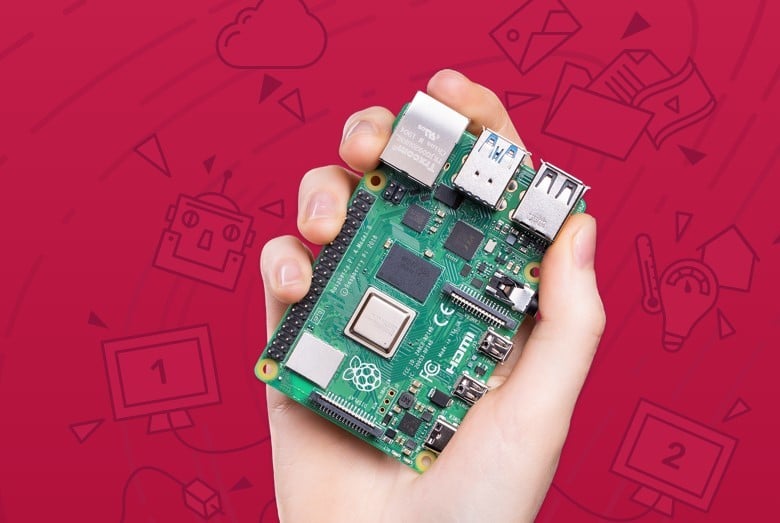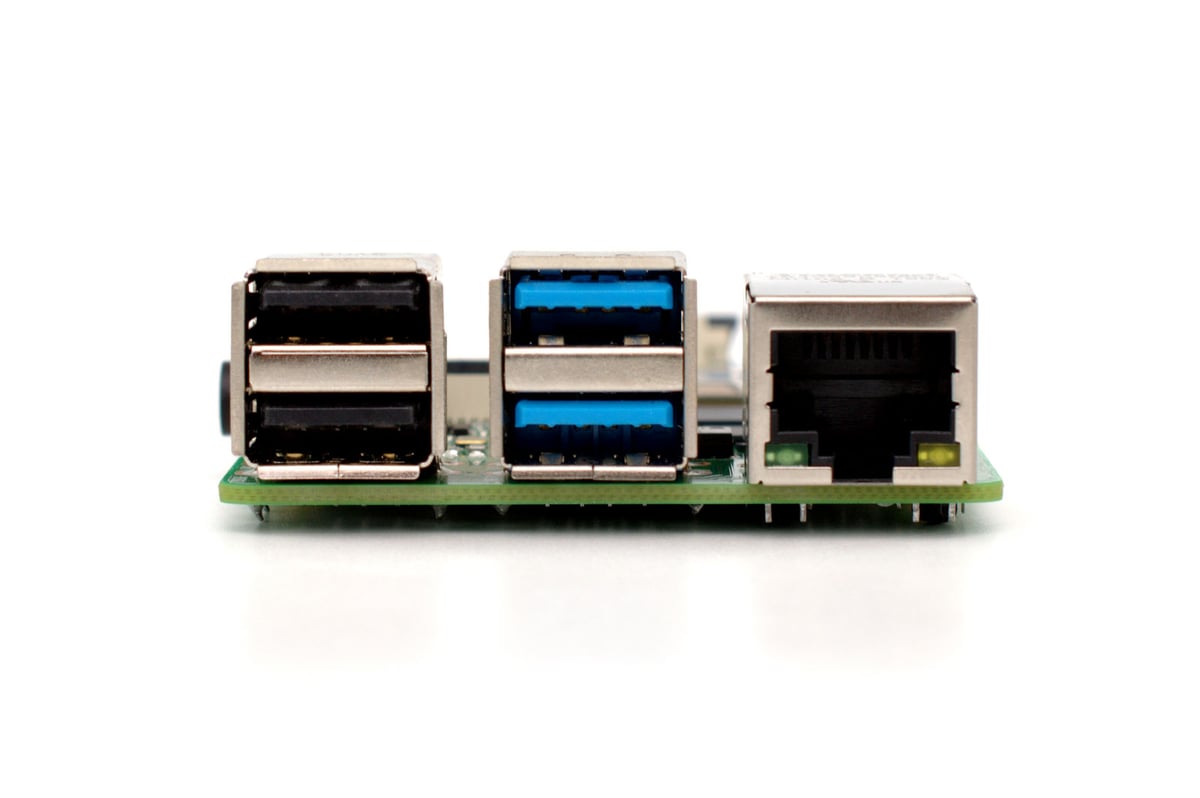The launch of the Raspberry Pi 4 back in 2019 demonstrated those in charge of the popular family of single-board computers were willing to experiment. Although superficially the same shape as Raspberry Pi 3 and earlier models, the new board brought with it some significant changes, not least of which was a move away from a single full-size HDMI port to two micro-HDMI ports supporting dual displays.
The Raspberry Pi team has always been tight-lipped about upcoming product launches, and its plan for the Raspberry Pi 5 and beyond has not proven an exception. That doesn’t mean it’s not possible to guess where the future of the project may lead, of course, and armed with an overview of its history, our guesswork may yet prove accurate.
The original Raspberry Pi Model B launched in February 2012 – a device built for education but sold, in its initial quickly-sold-out production run, to tinkerers and hackers. A lower-cost Model A followed, but it wasn’t until 2014 the family would see its first big shake-up: The Raspberry Pi Model B+, tweaking the design with a more polished board footprint and a larger 40-pin general-purpose input/output (GPIO) header.
The overall design would remain unchanged through to the release of the Raspberry Pi 3 Model A+, with each generation bringing improved performance through faster and more capable CPU cores – though leaving the graphics processor, originally developed at Broadcom for set-top boxes, alone.
The Raspberry Pi 4 changed everything. The first truly new generation, it introduced dual-display capabilities, a considerably more powerful processor, a tweaked board design, and the family’s first new graphics processor since launch. Representing a break with the past, the Raspberry Pi 4 – and Compute Module 4, the system-on-module variant powered by the same chip – marks a new starting point.
The Certainties
With Raspberry Pi unwilling to comment on plans for future designs, there are nevertheless some predictions that can be made with extreme confidence.
Performance and Efficiency

Raspberry Pi 5, we can expect, will begin with a new system-on-chip design that boosts performance or efficiency – or both.
The Raspberry Pi 4’s BCM2711 chip has four Arm Cortex-A72 cores running at 1.5GHz. Its successor could offer something as simple as boosted clock speeds: The Raspberry Pi 400, a variant of the board built into a keyboard chassis with integrated cooling, pushes a revision of the same chip to 1.8GHz – and amateur overclockers have easily pushed the same parts to 2GHz or beyond.
New Core IP

Another possibility is a shift to a newer core IP. Arm’s Cortex-A76 offers a claimed performance gain of up to 35 percent over an equivalent Cortex-A75, which was in turn 20 percent faster than the Cortex-A73, itself 30 percent faster than the Cortex-A72 used in the Raspberry Pi 4 Model B’s current BCM2711 chip. All offer full backward compatibility with the Cortex-A72.
Coprocessors

The company could also add extra processing cores, as it did with the shift from single- to quad-core in the Raspberry Pi 2. These could be full-speed cores, lower-performance efficiency-boosting cores for background tasks, or even specialized accelerators: Raspberry Pi now has an in-house application-specific integrated circuit (ASIC) design time, responsible for its RP2040 microcontroller, and co-founder Eben Upton has said it is “overwhelmingly likely” future products will include coprocessors designed to boost the performance of machine learning workloads.
No New RAM Options

What is less likely to change is the amount of RAM available. Previous Raspberry Pi boards topped out at 1GB, while the Raspberry Pi 4 launched with up to 4GB and more recently introduced an 8GB model. The chip at its heart supports more, but there are no mass-produced 16GB modules suitable – and little room on the cramped board to put two 8GB modules side-by-side.
The Possibilities
While some directions for the Raspberry Pi are clear, others are less so. More the wishes of fans of the board, the following feature on rival boards and would keep the Raspberry Pi 5 in better stead.
PCIe Connectivity

That the next-generation Raspberry Pi will be faster is a safe bet: Every model launched, bar the ultra-compact Raspberry Pi Zero range and Raspberry Pi Pico microcontroller development board, has been faster and more efficient than its predecessor.
Just having more CPU and GPU power isn’t the be-all and end-all of successor designs, though. A large part of the real-world performance on the Raspberry Pi 4 came from the retirement of a USB bottleneck, present in all previous models, which dramatically increased the bandwidth available for peripheral devices. As well as unlocking the full performance of the board’s gigabit Ethernet port, it also allowed for two of the four USB 2.0 ports to be replaced with faster USB 3.0 versions.
USB 3.0 is, as its name suggests, a universal standard – but not an ideal one. The launch of the Compute Module 4, which does not include a USB 3.0 controller, showed a clear demand for accessing the underlying PCI Express (PCIe) connectivity on the chip – for everything from high-speed Non-Volatile Memory Express (NVMe) storage to desktop-class accelerator hardware.
Adding PCIe connectivity to the Raspberry Pi 5 could be a challenge, given the board’s small footprint – “put your finger on the bit of board that I could fit a bloody SATA connector on,” Eben Upton (co-founder and CEO of Raspberry Pi Trading Ltd) quipped when asked about adding extra connectivity to the Raspberry Pi 4 in 2019 – but it would dramatically improve its flexibility. Many rival boards have already done so, either placing an M.2-format slot somewhere on the board or adding a high-density connector out to a break-out board – something Raspberry Pi could mimic in its future designs.
Power over Ethernet (PoE)

Another feature users have demanded is native Power over Ethernet (PoE) support, currently only available using a Hardware Attached on Top (HAT) add-on board. Integrating PoE directly into the board would simplify cabling for networked applications but add bulk – and could tip the scales away from the board’s long-standing $35 launch price.
The Pipe-Dream
There’s another possible direction Raspberry Pi could take for future boards. While it’s not impossible, it’s less likely to appear in the Raspberry Pi 5: A complete shift away from Arm to the free and open-source RISC-V instruction set architecture (ISA).
RISC-V Architecture
That Raspberry Pi, an organization that has education at its heart, is interested in RISC-V is no secret: The company joined RISC-V International as a member back in 2019. While it’s entirely possible it did so simply to support the effort, its membership could also indicate a desire to build its own boards based on the RISC-V ISA – potentially using silicon designed by its in-house ASIC team.
It’s a possibility Upton has downplayed, pointing out “there’s an ocean of difference between building a really good microcontroller and building even the simplest application processor” in a 2020 interview. “A factor-of-10 engineering difference.”
Doing so would bring several advantages, however, not least of which would be that a RISC-V-based SoC designed by the company’s in-house engineers would not attract the royalties currently payable to Arm. It would also help make the Raspberry Pi range more open, and even contribute to education surrounding everything from ISA and chip design to low-level programming.
It would, however, also break the backward compatibility for which the Raspberry Pi family is famed. Even today, it’s possible to take a microSD card with the 32-bit version of Raspberry Pi OS from a Raspberry Pi 4 and put it into an original Raspberry Pi – or even an Alpha board, never publicly released – and have it boot just fine.
That hasn’t stopped the company’s rivals. While the commercial launch of the open-hardware BeagleV Starlight board has been canceled, Radxa has confirmed its own plan to launch a Linux-capable RISC-V Raspberry Pi-alike board – and others in the industry are targeting price points as low as $15.
Regardless of which, if any, of these predictions ring true, one thing seems clear: There’s little chance of the Raspberry Pi family losing its position as the best-selling single-board computer range any time soon.
License: The text of "Raspberry Pi 5: What to Expect" by All3DP is licensed under a Creative Commons Attribution 4.0 International License.